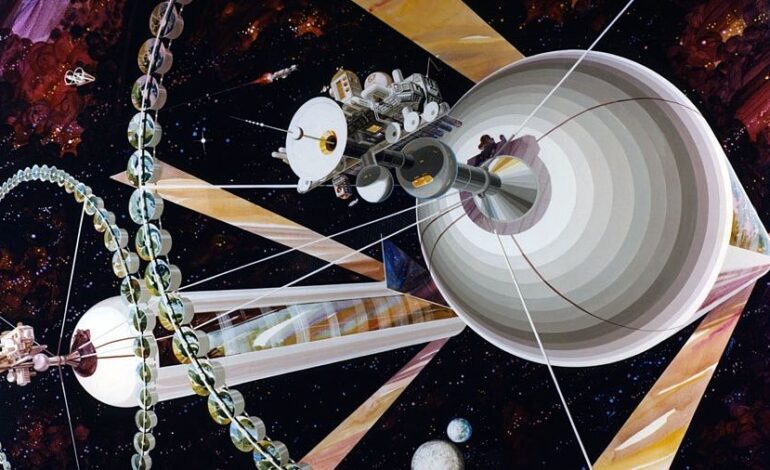Dream of Space Cities: How Reality Grounded O’Neill’s Vision

The ambitious vision of living in giant space cities has faced significant challenges since its conception. In the 1970s, physicist Gerard K. O’Neill from Princeton University proposed the idea of vast cylindrical habitats that could support millions of people, viewing Earth from their lofty positions. Despite the excitement surrounding this dream, the reality of 2025 paints a different picture, with only around 290 astronauts having spent time aboard the International Space Station and a handful in other space stations like Russia’s Mir and China’s Tiangong.
O’Neill’s vision was most famously articulated in his book, The High Frontier, published in 1976. He predicted that by the late 20th century, humanity could establish large space cities at the L5 Lagrange point between Earth and the Moon, with habitats capable of housing millions. The concept gained traction, giving rise to the L5 Society, which aimed to make these dreams a reality by 1995.
The foundation of O’Neill’s concept rested on the principle of rotation, creating a centrifugal force that would simulate gravity inside these habitats. His largest proposed model, known as Island Three, was designed to be four miles (6.4 kilometers) wide and 20 miles (32 kilometers) long, offering 500 square miles (1,294 square kilometers) of livable space filled with homes, parks, and recreational areas. This vision echoed elements seen in science fiction, notably the design of the Babylon 5 space station.
O’Neill envisioned a clean living environment, where industry and agriculture would be situated in smaller cylinders nearby, allowing for quick commutes via “commuterspheres” powered by electric motors. He estimated operational costs at merely 50 cents per passenger (in 1970s currency). Despite his compelling arguments, O’Neill’s expectations were overly optimistic, reflecting the technological climate of his time, which was buoyed by the success of the Apollo program.
In the late 1960s, O’Neill faced a unique challenge. He was tasked with teaching introductory physics at Princeton during a period marked by disillusionment due to the Vietnam War. With students skeptical about careers in science, O’Neill sought to inspire them by developing engineering problems that also addressed social and economic implications. His first question to students focused on whether the surface of a planet was the best place for a technological society.
O’Neill’s ideas were partly a response to the Club of Rome’s controversial report, Limits to Growth, which warned of a bleak future filled with overpopulation and environmental degradation. He proposed that, if Earth’s resources were dwindling, humanity should look to space for solutions. The 1970s boasted the technological capabilities to build these habitats, with O’Neill arguing that they could be operational by the early 21st century.
To construct these habitats, O’Neill suggested utilizing materials from lunar mining and near-Earth asteroids, transported to L5 using a method called a “mass driver.” This system, akin to an electromagnetic slingshot, could launch materials without the need for fuel, allowing for continuous operation.
Despite the theoretical basis for O’Neill’s vision, several obstacles hindered its realization. Although the concept of building space habitats is technologically feasible, the engineering challenges remain daunting. While the International Space Station serves as a testament to human ingenuity, it is far less complex than the proposed models of Island Three or its smaller counterparts.
The failure of the space shuttle program presented another significant setback. Originally envisioned for hundreds of launches annually, the shuttle completed just 135 missions from its inaugural flight in 1981 to its final one in 2011. This limited capacity curtailed the infrastructure development necessary for lunar mining and transporting people into orbit.
O’Neill’s initial cost estimates for constructing a 20-mile-long (32-kilometer) habitat hovered around $200 billion in 1970s dollars, which translates to approximately $1.1 trillion today. Additionally, social implications present further complications. Establishing space habitats might not remedy Earth’s overpopulation issues; having tens of millions in space would hardly address the needs of over 8 billion people on the planet.
Equally troubling are questions regarding equity and access. Historically, the affluent are more likely to benefit from such advancements, which raises concerns about widening the gap between wealthier and poorer nations. The challenge of ensuring fair access to space habitats may prove even greater than the engineering hurdles involved in their creation.
Despite these challenges, the idea of space habitats could provide a sanctuary for humanity, potentially mitigating existential risks posed by disasters on Earth. O’Neill’s vision serves as a reminder of the lofty aspirations of the 1970s, showcasing the hope for a future filled with technological wonders. Yet, as the world grapples with rising authoritarianism, environmental crises, and conflict, one must contemplate whether humanity has failed its future or if the future has failed humanity.






